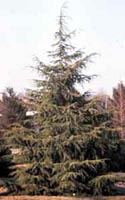Resource Library
Plant of the Week: Deodara Cedar
The University of Arkansas System Division of Agriculture does not promote, support or recommend plants featured in "Plant of the Week." Please consult your local Extension office for plants suitable for your region.
Plant of the Week
Deodara Cedar
Latin: Cedrus deodara

We gardeners always want to push the envelope -- to grow things where they just don’t
want to or won’t grow. Of the three species of true cedars, native from north Africa
to the Middle East and east to the Himalayan region, we naturally want to grow the
least hardy of these, the Deodara Cedar. This lovely conical evergreen tree grows
to 60 feet tall in about 50 years. But with great age, its lowest limbs will develop
into upward growing branches that can make the plant wider than it is tall.
The Deodara, a native Indian name for the tree, is indigenous from northern India,
into Afghanistan and east to Nepal. The true cedars do not make it over the Himalayan
Mountains or across the deserts of central Asia into China. In this country we call
the Juniperus virginiana the "cedar" tree, no doubt in reverence for the cedar of
the Bible which is Cedrus libani, the Cedar of Lebanon. Deodara cedar was introduced
into cultivation in England in 1831, probably arriving in the US by 1850 during the
new plant frenzy that occurred about that time. Unlike the stiff branches and short,
stout needles of the other cedars, the Deodara Cedar has more delicate branches, the
tips of which are usually drooping downward. The needles are a light green to gray-green
in color to an inch and a half long and needle-like.
Seed-grown Deodara cedars are only hardy as far north as zone 7, which means the
tree will grow in all of Arkansas except the Ozark Plateau region and the highest
parts of the Ouachita Mountains. Winter hardy forms of the tree have been collected
with ‘Shalimar’--a selection made in the Kashmiri region of India in 1963--probably
the most cold resistant. A similar selection called ‘Kashmir’ is also said to be cold
hardy but is probably not as hardy as the first-mentioned selection. Though I have
not grown these selections, they should be hardy to -5 to -10%F, making them suitable
for planting in the coldest parts of the state.
Deodara cedar is a finicky tree to grow. Like most conifers it requires excellent
drainage to prosper. But unlike many other members of the pine family, to which the
true cedars belong, Deodara cedar should have a good, fertile soil. In a good soil
it will be fast growing while young, often making two feet of growth a year. Be careful
when locating a planting site for this tree. Give it room. It is best used as a specimen
tree where the attributes of such a big tree can be shown to its full potential. This
is definitely not a plant for the foundation planting, as you sometimes see it used.
The tree is not without its problems. Sometimes it just dies. Usually the cause of
outright death can be traced back to root rot caused by planting in an insufficiently
drained soil. The other cause for sudden loss of the plant is often cold winters.
Young trees are more susceptible to cold than more established trees, but a very sudden
temperature drop such as we had in the Halloween freeze of 1994, can cause severe
damage to even older trees. The death of the tops of trees can usually be traced back
to freeze injury.
By: Gerald Klingaman, retired
Extension Horticulturist - Ornamentals
Extension News - November 5, 1999
The University of Arkansas System Division of Agriculture does not maintain lists of retail outlets where these plants can be purchased. Please check your local nursery or other retail outlets to ask about the availability of these plants for your growing area.